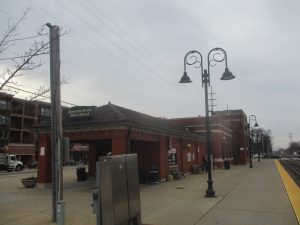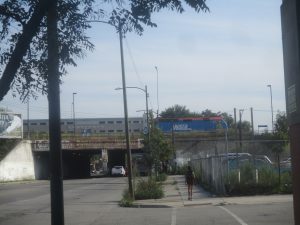Lipinski holds community meeting to address BNSF Line issues
By Igor Studenkov For Chronicle Media — December 23, 2018
An eastbound BNSF Line train races past Western station. (Photo by Igor Studenkov/for Chronicle Media)
Out of all the lines in Metra commuter rail system, no line attracts as many riders as BNSF Line, which connects Chicago to its western suburbs,
But in recent months, the growing number of riders has been complaining about late, overcrowded trains. During the summer, air conditioning broke down in its cars. Metra blamed the issues on the age of the cars, freight train interference and implementation of Positive Train Control train safety technology forcing it to reshuffle its schedules.
On Dec. 10, U.S. Rep. Dan Lipinski (D-Western Springs), held a community meeting to give riders a chance to share their concerns directly with Metra and BNSF Railway executives. And while it isn’t clear what would come of it, the congressman and the transit agency found the meeting productive, and more meetings may be in store in the future.
In prepared remarks, Lipinski said that the situation couldn’t continue.
“When [the BNSF Line] is working well, it’s an incredibly fast and efficient way to get downtown, especially during rush hour,” he said. “We all understand that problems can occur, but this year the Metra BNSF line has failed all too often. There have been repeated delays, cancellations, broken air conditioners, and other problems. I’ve told Metra and BNSF that this is unacceptable and the problems must end.”
BNSF Railway didn’t respond to calls and e-mails seeking comment.
Lipinski’s spokesperson Phil Davidson said that the congressman thought that the meeting was productive.
The BNSF Line runs between downtown Chicago and Aurora, making stops at Naperville, Lisle, Downers Grove, Westmont, Clarendon Hills, Hinsdale, Western Springs, La Grange, Brookfield, Riverside, Berwyn, Cicero and Chicago’s Pilsen and University Village neighborhoods. While most Metra lines provide multiple express trains toward Chicago in the morning and back to the suburbs in the evening, the BNSF line is unusual because it also provides multiple express trains in the opposite directions during rush hours.
Like the Union Pacific Metra lines, the BNSF line operates under the purchase of service agreement. The BNSF Railway company owns the tracks, and it operates the commuter trains on Metra’s behalf with its own crews.

A westbound BNSF Line express train races past Western station. The changes to the line’s schedule re-arranged many express trains, which, in some cases, left riders with fewer trains to choose from. (Photo by Igor Studenkov/for Chronicle Media)
According to ridership statistics compiled by Regional Transportation Authority, the BNSF Line remains the busiest line in the system in terms of ridership, with 1.38 million riders per month as of October 2018. By comparison, the second-busiest line, Union Pacific Northwest Line, had 934,507 a month.
But on-time performance has always been complicated by train interference. BNSF Railway’s freight trains share the tracks with Metra trains, and so do four Amtrak train routes. And in recent years, both Metra and BNSF Railway had to adjust schedules as they implemented Positive Train Control.
The system is designed to prevent train collisions and other accidents. Using the combination of GPS, wireless internet and radio transmissions, it tracks where the trains are and how fast they’re going. If the train is going too fast, or if it’s going where it’s not supposed to, and the train engineer does nothing, the brakes kick in automatically. U.S. Congress is requiring all passenger lines and most freight lines to have PTC up and running by 2020.
As BNSF Railway worked to put in PTC on the BNSF Line throughout 2018, Metra announced it would change its schedule. According to a May 9 press release, the issue was the rush hour trips where trains have to get to their final stop and head back out as soon as possible.
Before PTC kicked in, the crews could complete the process within 10 minutes. But once PTC did kick in, the process had to take around six minutes longer, which affected not only the trains turning around, but all of the other trains using the line at the time.
“Under PTC, the crew of a train must initialize the system before each individual run,” the press release stated. “With the added task of initializing the PTC system, these “flips” are expected to take 12 to 15 minutes, so the schedule of many trains must be adjusted for increased turn times, and those changes, in turn, will affect nearly all other trains on the schedule.”

Downers Grove’s Main Street station. The change to BNSF Line express service schedule means that Downers Grove riders have fewer rush-hour trips, putting more pressure on remaining trains. (Photo by Igor Studenkov/for Chronicle Media)
Metra spokesperson Michael Gillis indicated that, thanks to the aforementioned conflicts with freight trains, as well as the line’s overall capacity and the differences in ridership between station “severely restrict[ed]” their flexibility.
The impact of the changes varied depending on the train, with some travel times shifting as little as four minutes and some shifting as much as 24. But more notably, a number of express trains were restructured, with stops added or removed. In practice, this had a drastic effect on rush hour service. For example, under the previous schedule, Lisle and Downers Grove riders who wanted to leave after 7 a.m. and still arrive in downtown Chicago before 9 a.m., they had four express trains that skipped all stops east of Downers Grove and one more local train that only skipped stops between La Grange and Chicago. The new schedule left only three direct expresses and one more local express.
John Burns, of La Grange, said that, while he understood that the line’s schedule had to be adjusted due to PTC, the new schedule has resulted in overcrowded trains and station platforms.
“The line schedule needs to be reconsidered,” he said. “At the Union Station, [there is a] hazard [from] overcrowding on the the BNSF Line serves DuPage County suburbs, the Chronicle reached out to Don Puchalski, Chairman of the DuPage County Board Transportation Committee, to get his take on the situation. He responded by noting that the board advocates for the riders impacted by delays.
By August 2018, rider complaints got to the point that, according to a press release from Lipinski’s office, the “congressman brought Metra and BNSF together and put both on notice that they must fix the problems.”

A westbound BNSF Line train stops at Western station in Chicago’s Pilsen neighorhood. The train car sports Burlington Northern signage — a clue that it has been in service since at least the 1980s. (Photo by Igor Studenkov/for Chronicle Media)
While there was some progress, issues persisted, prompting him to call for the Surface Transportation Board, which has oversight over all American railroads, to take a closer look at the situation.
“Metra and BNSF pledged to hold more town-hall meetings in communities served by the BNSF line to provide commuters with updates and allow them to ask questions,” Davidson said.
Gillis also described the meeting as “constructive way to discuss ongoing issues and challenges with our riders” and that Metra “appreciated the passionate and civil discourse.”
“Our top priority is always to provide safe and reliable service,” he continued. “We and BNSF Railway are aware of the problems that exist on the line and know we must do better to provide more reliable service. The major challenges that we deal with on a daily basis are the constraints of our aging infrastructure and the volume of trains that we run through the corridor. We will continue to work with BNSF on scheduling and finding other ways to alleviate delays.”
Gillis said that Metra has been pushing for state and federal government to provide more capital funding to replace the aging train cars and infrastructure, which, he said, “would go a long way toward enhancing the customer experience.”
In his statement, Lipinski indicated that it was his priority as well.
“Right now I am working on getting a new federal infrastructure bill passed in Congress early next year,” he said. “I am helping the new governor [J.B. Pritzker’s] transition team on transportation and I’m hopeful the state will also step up.”
Puchalski said that he felt that he would fully support that.
“Our riders have done their share in funding Metra,” he said. “It is long past due for the state and federal governments to do the same.”







